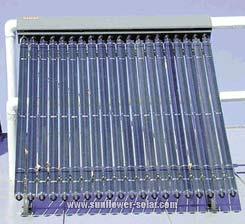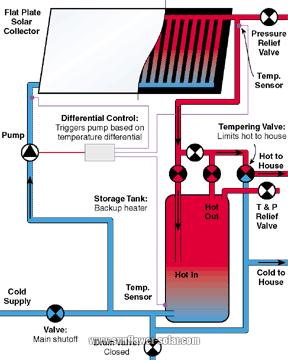Let us introduce more information about solar collector to you (Part four)
Author:Ken Olson
From:None
Post time:04/11/2012
View:3268
Selective Surface
A selective surface, the often referred to as "black chrome" referred to is far more efficient than a black-lacquered absorber area. Although a black surface is efficiently to absorb and convert sunlight into heat, it is out also very efficient again radiating Longwave infrared heat again. These losses to reduce collector efficiency.
A polished chrome surface would again broadcast the least infrared heat energy, but of course not black would absorb very little. A selective interface combines the best of both worlds; high degree of absorption with low emission. Sounds high-tech? It is already since the 1950s and is placed on the most commercially available flat-plate collectors. His performance is worth the marginal additional costs, particularly in cold climates where radiation heat loss is greatest.
Evacuated Tube Collectors

If you want the highest efficiency solar thermal collector, they are made interest on a vacuum tube collector, like that of Thermomax. Although tube collectors more efficient than traditional flat plate collectors are, they cost about twice as much per square metre.
Each tube and rib of the collector in a glass tube, which evacuated the entire air has been included. Why? Air leads to the cooler surface of the glass, to accelerate the loss of heat by convection heat from the hot surface of the tube. Remove the air and you have eliminated convective heat loss.
The tube with a selective surface is covered to minimize radiant heat loss. Evacuated tube collectors are best suited for high temperature applications (over 140 ° F, 60 ° C). You are useful to for other common applications at low temperatures, such as drinking water and space heating.
Collector to Tank Interface
Where the collector and memory is separated, a flow of water (or antifreeze) from tank to and back lead line must the system design. Small circulation pumps provide the necessary current with very modest energy demand. Small hot water systems can a direct current (DC) pump is powered by a single PV module (10 to 30 watts depending on power demand). You may be able to do without the pump completely, if you go for natural thermosiphon.
Thermosiphon System:
Natural Flow Powered by Gravity
Gravity forces convection flow in a thermosiphon system. Water in the collector is flamethrowing as it is heated and rises to an elevated tank. Cooler, heavier water falls from the tank take his place. For best results, the top of collectors provide at least a foot (30 cm) below the bottom of the tank. Greater altitude will result in greater flow. Larger pipes, smaller editions and gentle curves will make for a sufficient flow rate.
If you will need protection, it is not hard to do. The collectors (propylene glycol is the most common) are filled with an antifreeze solution. The heat can be transferred to the water through a heat exchanger.
Direct Pump Recirculation
The direct pumping system uses an electric pump to move heat from the collector to the storage. This means that you are free required by restricting the placement of the Collector under the tank, such as flow of thermosiphon. The pump can move the heat from the rooftop to a tank in the basement. Good sense calls for minimum length of the pipe for efficiency.
A differential controller switches the pump on or turn off, as needed. There are two sensors, one on the outlet of the collectors and the other at the bottom of the tank. The pump, signal of the controller if the collector outlet in turn 20 ° F (11 ° C) warmer than the bottom of the tank. It turns off when the temperature difference is reduced to 5 ° F (2.8 ° C). You can set some systems to the hysteresis.